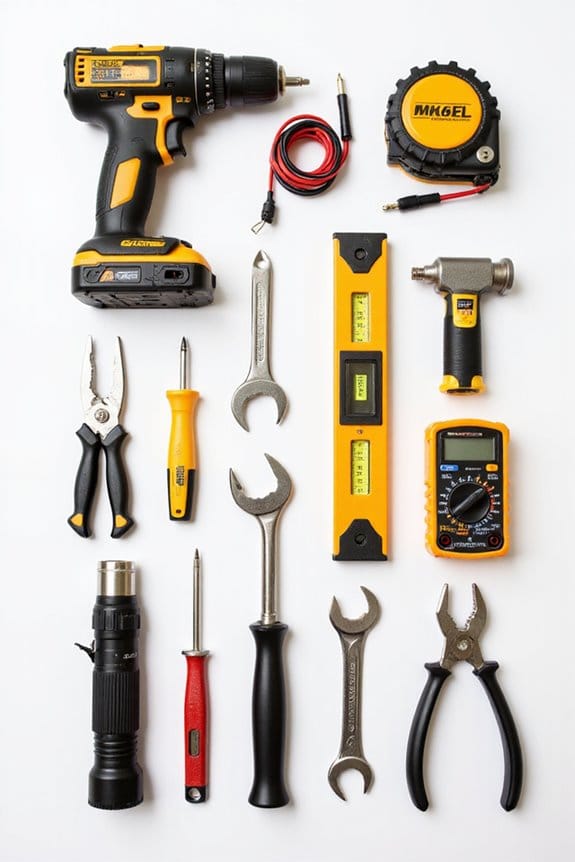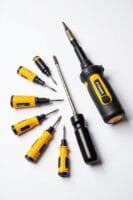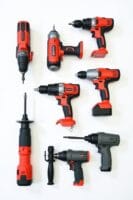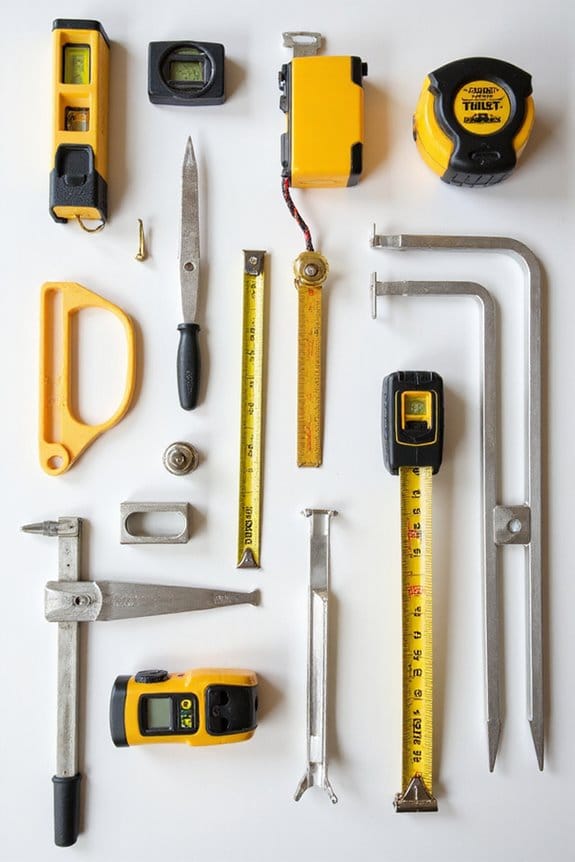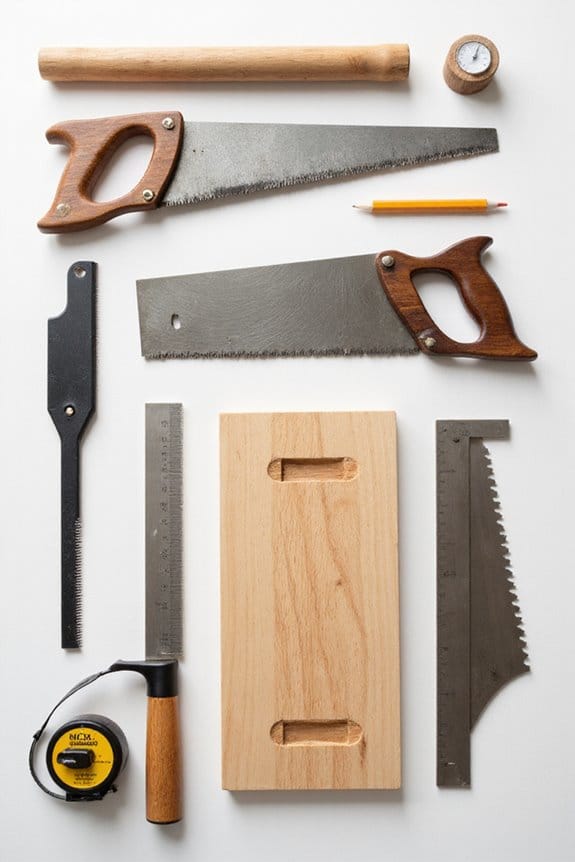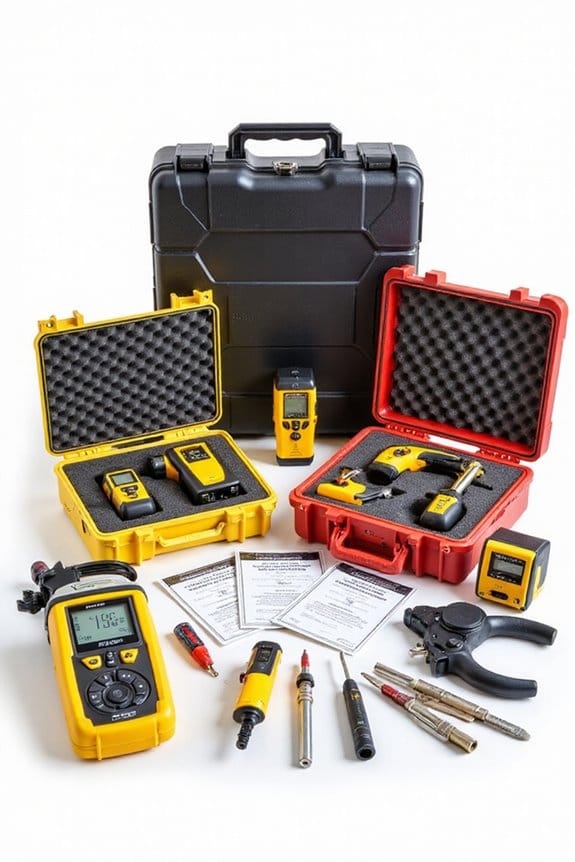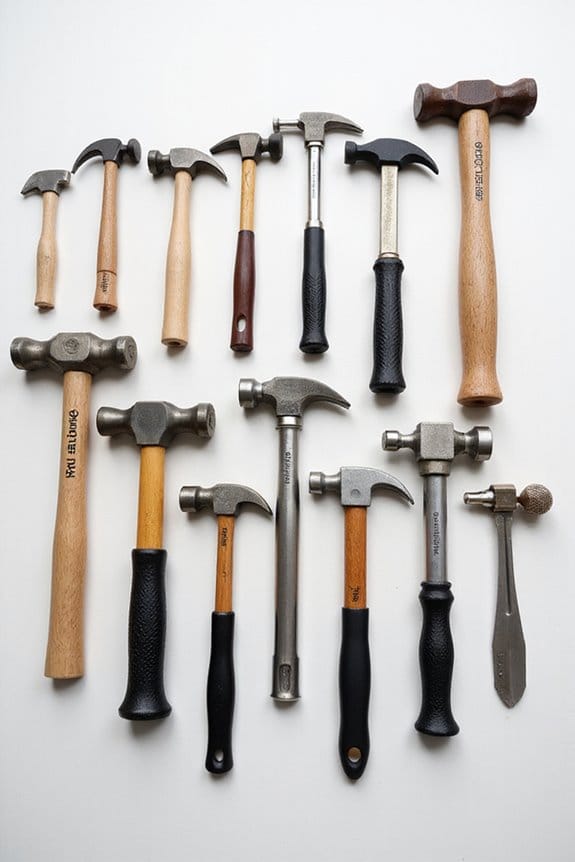For basic home maintenance, you’ll need a few essential tools. First, grab a utility knife for clean cuts and a claw hammer for driving nails. You’ll also want a screwdriver set and an adjustable wrench for versatility. Don’t forget measuring tools like a tape measure and spirit level for accuracy. Safety gear like goggles and gloves is a must to keep you protected. Ready to tackle some home projects? There’s even more handy info coming up.
Key Takeaways
- A utility knife is essential for making precise cuts on drywall, carpet, and cardboard during home repairs.
- A claw hammer is ideal for driving nails and features a comfortable grip for ease of use.
- A complete screwdriver set with flathead, Phillips, and square tip drivers is necessary for various fastening tasks.
- Measuring tools like a tape measure and spirit level ensure accurate measurements and level surfaces in your projects.
- Safety gear, including protective eyewear and gloves, is crucial for preventing injuries during home maintenance tasks.
Essential Hand Tools for Home Repairs
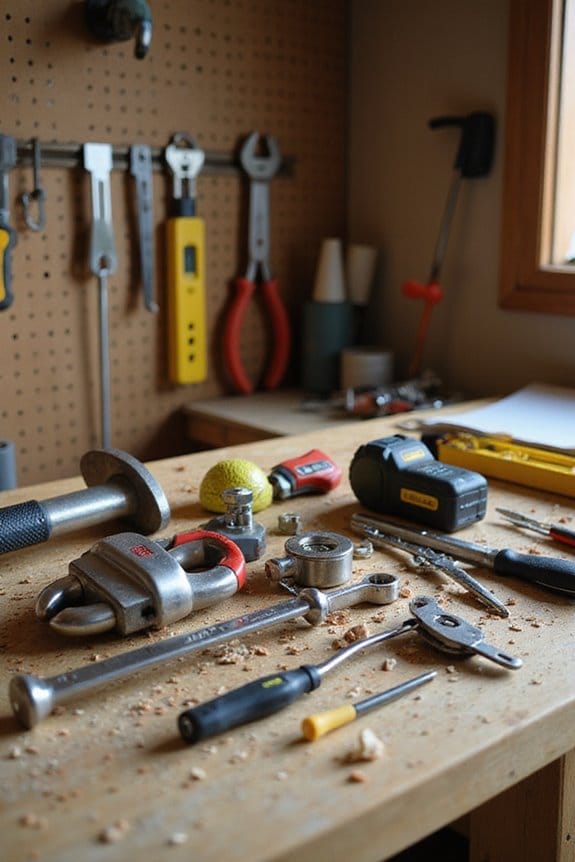
When it comes to tackling home repairs, having the right hand tools can make all the difference. Here are some essential hand tool types I recommend for your toolkit:
- Utility Knife: Perfect for precise cuts on drywall or carpet. Always keep spare blades handy!
- Claw Hammer: This versatile tool drives nails and has a comfy grip.
- Screwdriver Set: A must-have with flathead, Phillips, and square tip drivers for all your fixture needs.
- Adjustable Wrench: Great for tightening or loosening bolts without damaging them.
- Pliers: Channel lock and needle-nose types are essential for gripping and bending. Additionally, investing in high-quality tools made from chrome-vanadium steel can enhance durability and performance.
Measuring and Leveling Tools
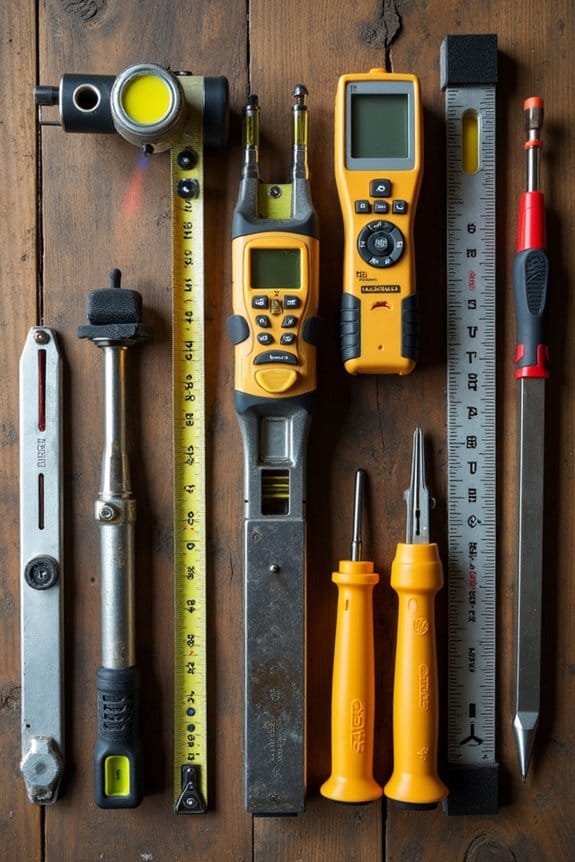
Measuring and leveling tools are the unsung heroes of home maintenance. Without them, our projects could quickly go sideways! Here are some essentials I recommend:
- Tape Measure: Perfect for measuring length, width, and height. With dual markings in imperial and metric, you can tackle any project effortlessly.
- Spirit Level: This tool guarantees leveling accuracy. It checks if surfaces are straight, so your shelves don’t look like they’re climbing a hill!
- Stud Finder: Avoid drilling into wires! This nifty gadget helps locate studs behind walls, making heavy installations safer.
- Angle Finder and Speed Square: Need precise angles? These tools help with marking and cutting, guaranteeing your woodworking is spot on.
Additionally, investing in high-quality tools can enhance measurement accuracy and ensure your home projects stand the test of time. With these measuring techniques, you’ll ace your home projects!
Cutting and Fastening Tools
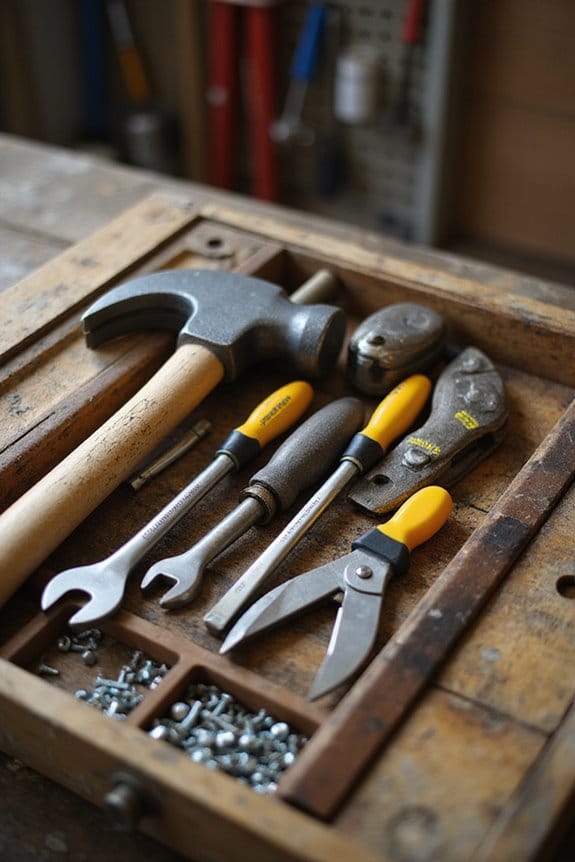
After you’ve got your measuring and leveling tools sorted, it’s time to tackle cutting and fastening tools. Here’s what I recommend:
- Utility Knife: Perfect for precise cuts in drywall and cardboard. Keep spare blades handy!
- Handsaw: Great for wood and PVC; choose one with a fine-tooth blade.
- Hacksaw: Essential for cutting metal and plastic—trust me, you’ll need it.
- Hammer: A must-have for driving nails; get a good claw or ball-peen.
- Screwdriver Set: A variety of flathead and Phillips screwdrivers makes fastening methods easier.
With these cutting techniques and fastening tools, you’ll be ready to tackle most home projects. Remember, a little practice goes a long way! Happy fixing!
Electrical and Lighting Tools
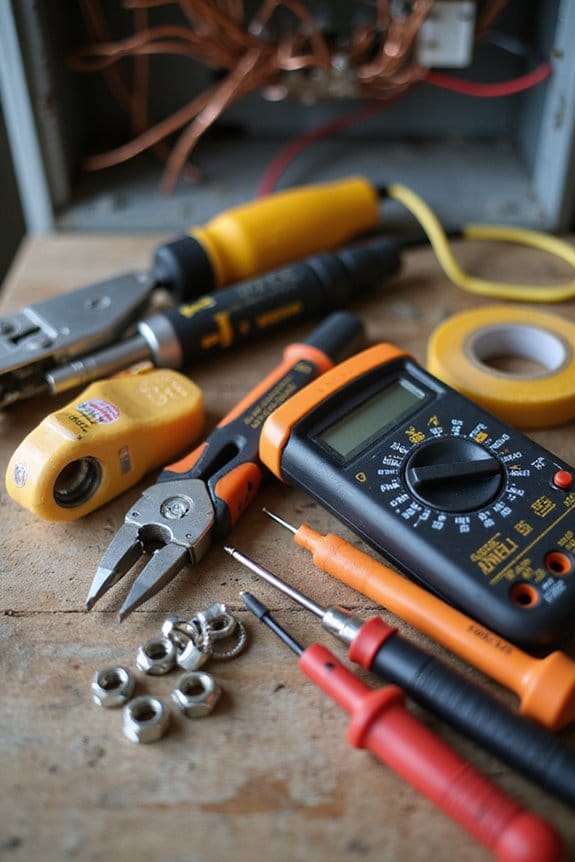
You’ll find that having the right electrical and lighting tools can make a world of difference in your home maintenance projects. Here’s a quick rundown of essentials:
- Wire Strippers: These are essential for removing insulation without damaging the wire. Trust me; you’ll appreciate this tool when your fingers aren’t getting nicked!
- Voltage Testers: Safety first! These handy devices help you check for live wires, ensuring you don’t turn your DIY into a shocking experience. A good voltage tester features non-contact detection for safer voltage checks.
- Screwdrivers: A mix of flathead and Phillips is important for your outlets and fixtures.
- Pliers: Needle-nose and lineman types are perfect for gripping and twisting wires.
With these tools, you’ll be ready to tackle most electrical tasks safely and efficiently. Happy fixing!
Miscellaneous Small Tools and Accessories
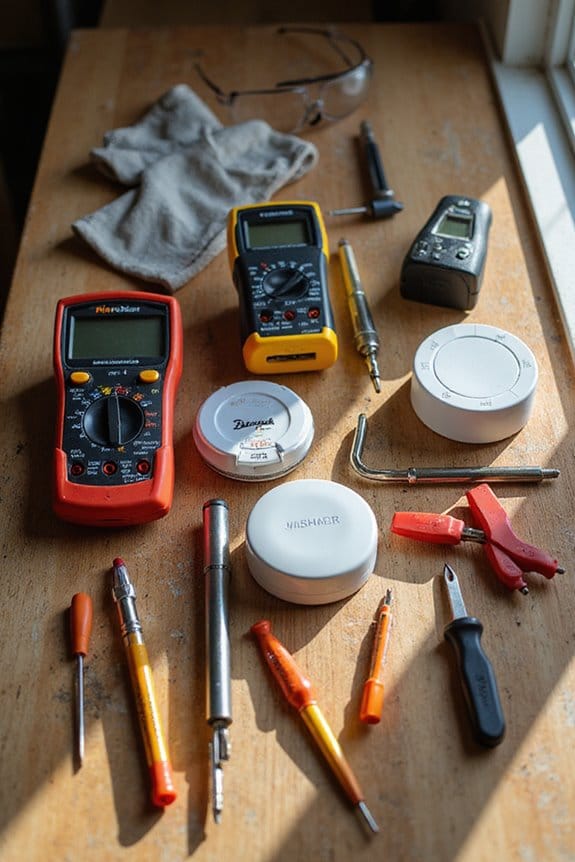
When it comes to home maintenance, having a collection of miscellaneous small tools and accessories can really save the day. Here are some essentials I always have on hand:
- Sandpaper: Perfect for smoothing surfaces after repairs.
- Tape types: Duct tape and electrical tape are lifesavers for quick fixes.
- Zip ties and small fasteners: Great for organizing cables or securing loose parts.
- Putty knife: Ideal for applying fillers or scraping surfaces.
- Small container or organizer box: Keeps screws and nails sorted, preventing chaos.
These tools might seem minor, but trust me, they make a world of difference. You’ll be amazed at how handy they can be when tackling a home project. Additionally, investing in ergonomic tool designs can enhance comfort and efficiency during your maintenance tasks. So, stock up and get ready for anything!
Essential Maintenance Consumables
Having the right maintenance consumables handy can make all the difference in keeping your home running smoothly. Here are some essentials I recommend:
- HVAC Supplies: Change air filters monthly for better air quality. Don’t forget to clean refrigerator coils regularly to save energy.
- Plumbing Repair Essentials: Keep sink drain cleaners around to tackle clogs. Replacement faucet washers can fix pesky leaks, saving water and your wallet.
- Cleaning Supplies: A good window cleaner and microfiber cloth will keep your views crystal clear.
- Sealing Materials: Weatherstripping and caulking materials are vital for energy efficiency. Additionally, having leak detection equipment can help you identify and address potential plumbing issues before they escalate.
Safety Gear for Home Maintenance
Safety gear is a must-have for anyone tackling home maintenance tasks. Trust me, you don’t want to skip it! Here’s a quick list of essentials for injury prevention:
- Protective Eyewear: Safety goggles shield your eyes from dust and sharp objects. They’re affordable and essential for protecting your vision.
- Protective Gloves: Whether you choose leather or rubber, gloves protect your hands from scrapes and punctures. Just make sure they fit well!
- Hearing Protection: Earplugs or earmuffs are important when using loud tools. Protecting your ears is just as significant as protecting your hands.
- Respiratory Protection: Dust masks or respirators are necessary for tasks like painting or sanding. They keep harmful particles at bay.
Invest in quality safety gear; your future self will thank you!
Organizing Your Tool Kit
Organizing your tool kit is an essential step that can save you time and frustration during home maintenance projects. Here are some tips I’ve found helpful:
- Tool Categorization: Gather all your tools in one place and separate hand tools from power tools. Group similar items together, like all screwdrivers in one spot.
- Storage Solutions: Use drawer dividers to keep everything neat. I like portable tool boxes for easy transport, and pegboards for visibility.
- Accessibility: Identify your most-used tools and keep them where they’re easy to grab. Labeling drawers can also speed things up.
Lastly, remember to regularly declutter your kit. Trust me, a well-organized tool kit makes every project smoother—and I can’t be the only one who’s tired of searching for that one screwdriver!
Frequently Asked Questions
How Do I Choose the Right Tool for a Specific Task?
When choosing the right tool for a task, I consider tool types and their task suitability. I assess the job’s material and precision needs, ensuring I select the best tool to get it done effectively.
What Are the Best Brands for Home Maintenance Tools?
When I explore tool brand comparisons, I find top tool manufacturers like Milwaukee, DeWalt, and Bosch stand out. Their reliability and performance make them my go-to choices for home maintenance tasks, ensuring I get the job done right.
How Often Should I Replace My Tools?
I know replacing tools can feel unnecessary, but keeping a solid maintenance schedule is essential. Tool lifespan varies; generally, I replace them every few years or sooner if I notice wear or damage.
Can I Borrow Tools From Neighbors Instead of Buying?
I’ve found tool sharing through neighborly exchange really beneficial. It saves money on seldom-used tools, strengthens community ties, and lets me tackle projects without the hassle of storing or maintaining equipment I rarely use.
What Should I Do if a Tool Breaks During Use?
Did you know that nearly 30% of tool-related injuries occur from using broken equipment? When a tool breaks, I immediately stop, prioritize safety precautions, and assess for repairs before considering replacement. Always handle with care!

